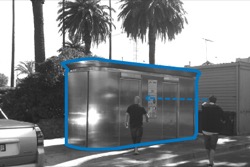On this page:
About small public buildings and structures
Small public buildings and structures include:
- kiosks and vendor stalls
- shelters
- toilets
- bicycle storage cages
- utility buildings such as electrical substations, which are most often located in public spaces.
While most small public buildings and structures are permanent, some may be temporary or relocatable to allow for the flexible use of public spaces.
6.7.1: ensure small public buildings and structures are accessible and support use of public spaces
- Locate small public buildings and structures where there are opportunities for informal surveillance from nearby activities.

- Locate small buildings and structures to be visible from a distance and adjacent to a busy pedestrian route.
Tip: passers by will provide a level of informal surveillance of the building.
- Position small public buildings and structures to allow clear passage for pedestrian and bicycle paths.
6.7.2: ensure small public buildings and structures are safe and attractive
- Provide an open approach path to the small public building or structure.
Tip: people feel safer approaching the building where they have clear open sightlines to surroundings.
- Site the building or structure to provide adequate circulation space around it.
- Shape the exterior of a small public building or structure to eliminate potential concealment places.
- Provide shelter from wind, rain and sun for visitors to the building.
- Provide lighting to all sides of the building.
Page last updated: 09/06/23